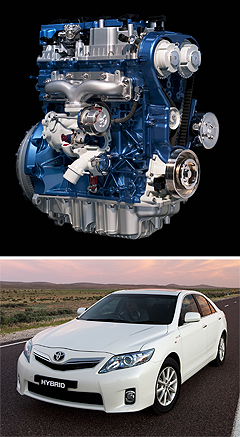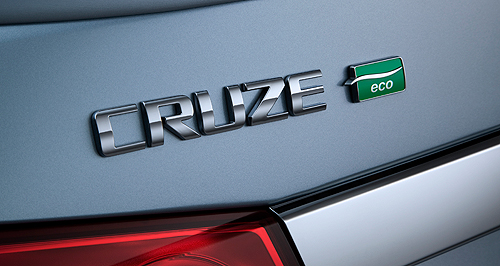Make / Model Search
News - General NewsCar-makers hit the green boostCleaner: Holden's locally-built Cruze is just one Australian car set to get more environmentally friendly technologies. $700 million to be injected into eco-car projects in one year as industry ramps up14 May 2010 AUSTRALIAN automotive industry investment on green car technologies is set to spike to about $700 million in 2011-12 as local car-makers and suppliers ramp up development of eco-friendly vehicles to ensure their survival. Facing tougher Euro 5 emissions laws from about 2014 and compulsory C02 emissions targets now being drawn up by the federal government, the manufacturers have signalled their intention to dip deeper into Canberra’s Green Car Innovation Fund after this year. The government has budgeted $104 million to come out of the 10-year fund to assist eco-car development projects next financial year – including assistance for Holden’s new small car to be launched in the first half of next year and Ford’s 2011 EcoBoost four-cylinder Falcon. But federal budget forward estimates released this week show that this jumps almost 70 per cent to $173 million in 2011-12 for confidential projects foreshadowed in commercial-in-confidence applications to the federal industry department and its minister Kim Carr. As companies are required – with some exceptions – to match each federal dollar with three of their own, this $173 million translates into about $700 million in investment on research and development, tooling and other costs of bringing qualified projects to fruition. Future funding may include low-emissions variants of the locally produced Holden Cruze hatch and sedan using E85 ethanol, LPG, compressed natural gas (CNG) or range-extender plug-in hybrid technologies, which were mooted when Holden announced the project in late 2008. A next-generation Toyota Camry Hybrid with plug-in electric charging might also be on the agenda.  Left: Ford's EcoBoost four-cylinder engine. Below: Toyota Camry Hybrid. Left: Ford's EcoBoost four-cylinder engine. Below: Toyota Camry Hybrid.Part of the spending is likely to be on engines and engine plants to bring them up to speed to meet the new emissions rules that will get even tougher by about 2016 or 2017 when Euro 6 restrictions are due. These engines almost certainly will include new-generation liquid-injection LPG, E85 ethanol and CNG-capable variants to counter expected hikes in petrol prices as “easy oil” depletes and new oil reserves become more difficult and expensive to access from deep-sea oil fields and oil sands. Ford and Toyota engine plants are in danger of closure unless they can secure head office support for new-generation, cleaner and more efficient engines for the locally produced Falcon and Camry. While the future of Holden’s newer Port Melbourne engine plant appears more secure, it will need further investment in new technologies to ensure that booming exports of its direct-injection V6 to China, Korea and Mexico remain on track as customer markets tighten environmental demands towards 2020. At a time when requests for assistance from the Green Car Innovation Fund are set to go up, the federal government has announced a $200 million cut to the fund over three years from 2011 to 2014, reducing it from $1.3 billion over the full 10 years from 2009 to 2019, to about $1.1 billion. The cuts were apparently made because of lower than expected uptake of grants, especially from financially-constrained parts-makers who had difficulty accessing investment backing in the global financial crisis. While the industry has described the slice as disappointing, it says the remaining funds – said to be $790 million over the remaining nine years of the scheme – should be sufficient to cover the industry’s needs. Federal Chamber of Automotive Industries (FCAI) CEO Andrew McKellar told GoAuto that the industry accepted the circumstances of the “regrettable” cuts. “I am sure a number of very important investments by the local vehicle manufacturers and component suppliers will proceed with support from the program,” he said. “What we have to seek to do is ensure the remaining program funds are put to work so the program achieves its goals.” Mr McKellar said time would tell if the fund ran dry before it was scheduled to end in mid 2019, but he said the federal government would likely look kindly on any worthwhile project anyway. “I would be very surprised if there wasn’t some sort of government support for any genuine proposal that was brought to their attention, provided the numbers stack up,” he said. Mr McKellar said the rise in federal government forward estimates for Green Car Fund spending in 2011-12 and 2012-13 reflected the natural take-up by companies as they brought projects to fruition. “I am sure there are other things that the motor vehicle manufacturers are looking at, that are in the pipeline,” he said. As grants to any one manufacturer are capped at $300 million, all three local car companies are likely to max-out their Green Car Fund grants, with parts-makers and independent R&D organisations getting the rest. Holden is believed to be already half way there, putting its hand up for about $140 million, mainly for development of the local Cruze that will be launched with an efficient 1.4-litre turbo-charged engine and made at Holden’s Elizabeth plant in South Australia. Ford has been the second biggest applicant, with about $100 million in grants, mainly to engineer the overseas-made 170kW 2.0-litre turbocharged four-cylinder engine into the rear-drive Falcon for launch in 2011, along with a turbo-diesel Territory and a liquid-injected LPG six-cylinder engine for Falcon. Toyota so far has drawn down only about $35 million for the Camry Hybrid that went into local production at Altona, Victoria, late last year for a local launch in February. While the federal government chopped $200 million from its forward estimates for the Green Car Fund, the broader $3.4 billion Automotive Transformation Scheme (ATS) to assist the industry to modernise over the next decade was untouched. Legislation for the ATS passed through parliament late last year, just before the government cut tariffs on imported passenger cars to five per cent.  Read more |
Click to shareGeneral News articlesResearch General News Motor industry news |










Facebook Twitter Instagram